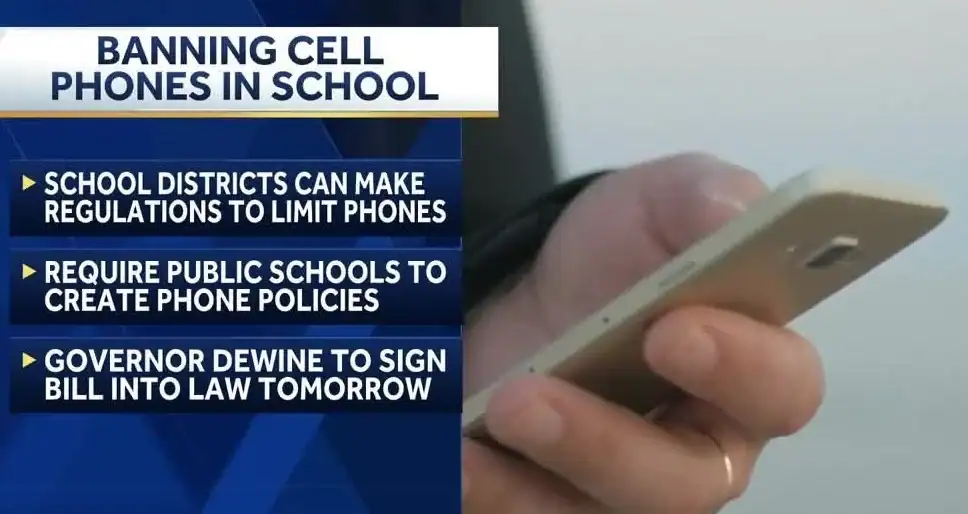|
|
By Evelyn Rossman
Students will soon forgo texting for textbooks thanks to the new phone ban for all Ohio public schools, which will take effect in July 2026. The ban has mostly drawn support from parents and teachers, but some have raised concerns about student safety.
The Cell Phone Issue
Cell phones are increasingly relevant to students’ lives, even in the classroom. A recent study from Seattle Children’s Research Institute found that the average adolescent (13-18) spends an average of 1.5 hours on their smartphone during a 6.5-hour school day.
A growing collection of research has revealed the damage that phones have on student interactions and focus. According to one 2022 study, smartphone notifications can distract everyone in a classroom, leading to slower task completion. Teachers, like Sarah Davis, are well aware that phones are a significant detractor from classroom learning.
“Thinking about your phone, and checking your phone all the time, is really bad for concentration,” said Davis, a history and government teacher at Shaker Heights High School (SHHS). “For certain kids, it can be incredibly harmful…it has lowered their ability to get through the school day.”
On June 30, Mike Dewine signed a statewide phone ban for Ohio public schools. This provision, a small section of Ohio’s sweeping budget bill, requires all public schools to enforce cellphone bans by January 2026, with exceptions for medical emergencies. This ban solidifies into law a growing nationwide trend of phone restrictions in schools.
The Rise of Yondr
Currently, 77% of public schools across the US have cell-phone policies prohibiting phone use. Last August, Shaker Heights City School District (SHCSD) instituted Yondr pouches at both Shaker Heights Middle School (SHMS) and High School. Yondr pouches are individual containers for students’ phones that are magnetically locked during school hours. Other Cleveland schools hopped onto the Yondr trend, including those in the Cleveland Metropolitan School District.
“We’ve [seen] a real culture shift,” said David Glasner, superintendent at SHCSD. “If a student…has not put their phone in a Yondr pouch, and they decide to use it when they’re walking between classes in the hallway, it is very obvious.”
Glasner says that Ohio’s new phone ban will simply reinforce what Shaker is already doing. However, some teachers and students say that the Yondr pouches aren’t entirely effective. Cassie Lyles, a rising senior at SHHS, says that students quickly found ways to cheat the system.
“You could easily put something else in the Yondr pouch,” she said. “I would see calculators, old iPods…someone made a clay phone in [art class] and put it in their Yondr pouch.”
Community Members’ Reactions
The ban has been met with support from the majority of parents. Carrie Rhodes, a Shaker Heights mother of four, says that she’s grateful to know that her kids will be off their phones in the classroom.
“I think [most] parents have read the research and seen from their own experience [that] the phones are a distraction,” she said. “They’re not helping during the day.”
Some parents, however, are wary of student phone bans. They worry that they won’t be able to reach their child during an emergency, or that school coaches won’t be able to communicate with athletes.
“The logistics of parenting are really challenging, so I understand parents today wanting to be in touch with their kids,” said Davis. “Parents feel, for lots of reasons, that [their kid will] be in trouble if they’re not keeping track of [them] all the time.”
Glasner says that the issues of communication can be solved by using PA systems and landlines already present in classrooms. Additionally, he says that phones can sometimes create more chaos during an emergency.
“Let’s let students and teachers focus on learning and teaching,” he said, “and chances are, whatever information we need to get out, we’ll get out at the appropriate time.”
Despite criticisms, Yondr pouches have seen positive results in a relatively short period. Lyles said that separation from her phone improved her focus and grades. Glasner also mentioned that he’s seen much more student connection in the hallways and cafeteria. With the new legislation backing them up, he hopes this will continue to grow.
“Those kinds of social interaction opportunities are so much healthier for all of us,” he said. “So, it’s nice to see us getting closer to that point.”






